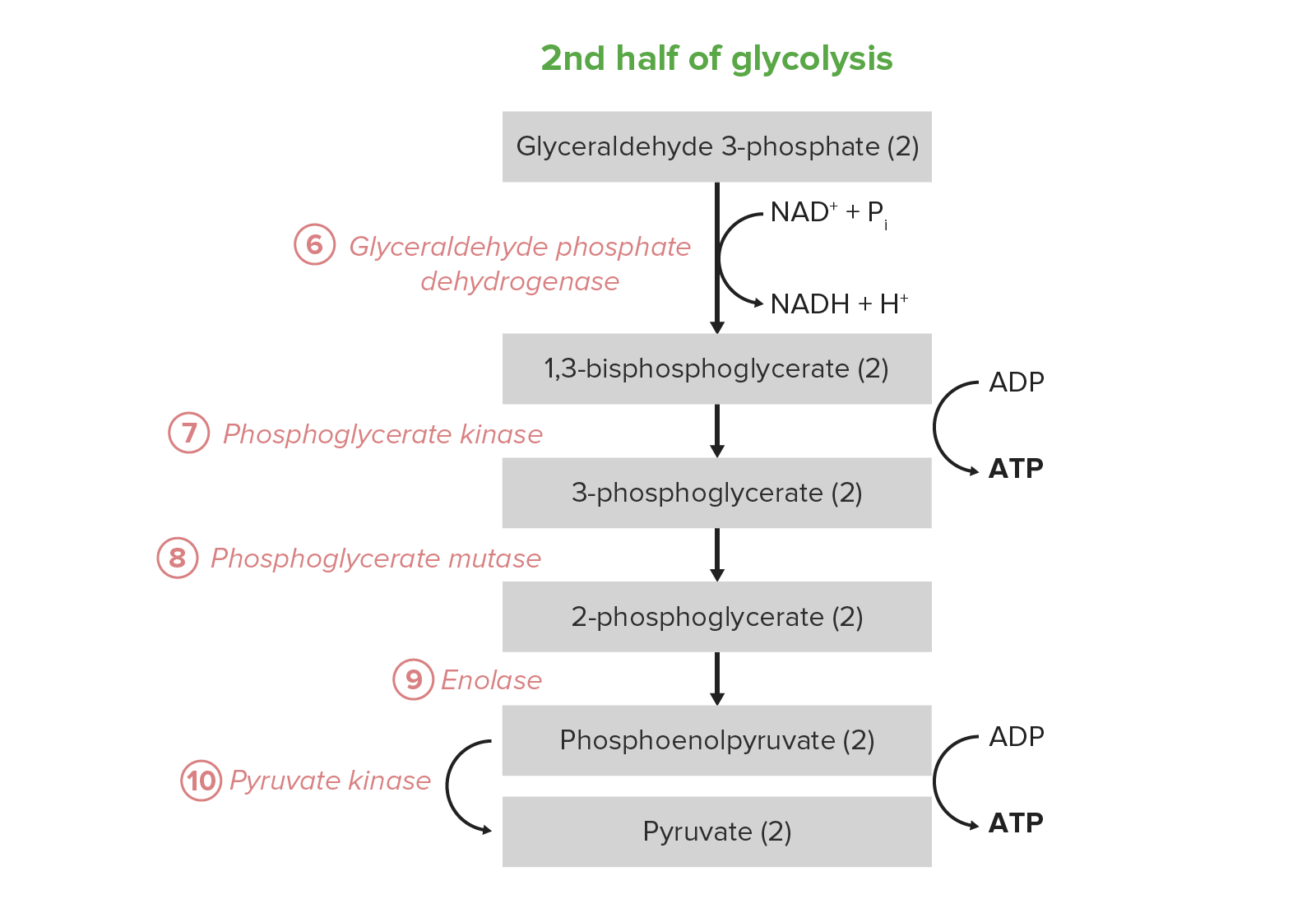Playlist
Show Playlist
Hide Playlist
Glycolysis: F6-P –> F1,6-P – Glycolysis and Pyruvate Metabolism
-
04 Advanced CarbohydrateMetabolism.pdf
-
Reference List Biochemistry.pdf
-
Download Lecture Overview
00:00 Now fructose-6-phosphate is converted into fructose-1,6-bisphosphate in the next reaction, and this is probably the most interesting reaction of glycolysis. 00:11 In this reaction, we are seeing fructose-6-phosphate gaining an additional phosphate and becoming the 1,6-bisphosphate on the side. Why is that interesting? It's interesting because of the enzyme that catalyzes that reaction. 00:25 Phosphofructokinase also known as PFK-1 catalyze a reaction very much like what hexokinase did uses the energy of ATP to put a phosphate onto one of the hydroxyls on fructose-6-phosphate. 00:41 In this case the phosphate is going onto hydroxyl on position number 1. 00:46 Now this, as we can see, is going through the same mechanism or the same steps that we are going through in the hexokinase reaction so the phosphate ends up on here. 00:56 Now this enzyme is interesting and important because it's a regulatory enzyme. When I describe regulatory enzyme, what I am talking about are enzymes that can be turned on or turned off by various things. 01:11 In the case of hexokinase, for example, it was a regulatory enzyme because it was turned off by it's product, which was glucose-6-phosphate. 01:20 Now this enzyme is turned off or on by several products and these products are interesting for us to consider. 01:29 The delta G zero prime for this reaction is -14kJ/mol. 01:33 So very favorable in the forward direction and the reason it's favorable in the forward direction is for the same reason for hexokinase reaction that's favorable and that is coupled with the hydrolysis of ATP. 01:46 Now discussing phosphofructokinase and it's regulation gives us some interesting perspectives. 01:53 First of all, there are two materials or two compounds that favor the activation of phosphofructokinase. One of these is AMP. 02:02 Now AMP is related to ADP and ATP. 02:08 The ATP being the triphosphate. The ADP being the diphosphate and the AMP being the monophosphate. 02:16 Well as we talk about the nucleotides, the more phosphates they have, the more energy they have. 02:21 And AMP is a form of adenosine nucleotide that has very low energy. 02:29 Cells usually don't have much AMP in them and the only time they have AMP in them is when they are running out of the energy. 02:37 So when they are running out of energy, they really need to have a boost in that energy, and one of the boost in that energy is to activate a process that will make energy such as the breakdown of sugars. 02:47 So a low energy indicator like AMP encourages the process of glycolysis to occurs so that the cell can generate some energy. 02:56 Now fructose-2,6-bisphosphate doesn't fit into that scheme. Fructose-2,6-bisphosphate regulation is a little bit different and it will be covered in another one of the these lectures. 03:08 ATP inhibits phosphofructokinase. 03:12 Now that make sense because ATP in abundance indicates the cell has got a plenty of energy. 03:17 You don't wanna be breaking your sugar down if you have more than enough energy just like you don't wanna be lighting your fire place in the middle of summer. 03:25 It doesn't make sense to waste energy that way. 03:29 Now, how does this happen? If we think about PFK, it has a substrate for ATP. 03:37 And one of the things that we learned about enzymes is that the greater the substrate concentration, the faster the reaction goes. So how is it that one of the substrates of PFK is inhibiting the enzyme? Well it turns out that the enzyme actually has two different binding sites for ATP. 03:57 One of the binding sites is the binding site for the allosteric affects that is turning the enzyme off. 04:03 And the other binding site on the enzyme is for the active site where the reaction is catalyzed. 04:10 Now you are probably getting ahead of me at this point. But what happens is the these two binding sites have different affinities for ATP. 04:20 That's important because if we have low energy we want this reaction to go. 04:25 That means that the active site which binds the ATP has a greater affinity for ATP than the allosteric site. 04:32 And only at high concentrations of ATP where the allosteric site start to bind ATP. 04:37 That's a remarkable process and there are very few enzyme that exhibit this property.
About the Lecture
The lecture Glycolysis: F6-P –> F1,6-P – Glycolysis and Pyruvate Metabolism by Kevin Ahern, PhD is from the course Carbohydrate Metabolism.
Included Quiz Questions
Which statement below about phosphofructokinase (PFK) is NOT true?
- PFK is activated by high concentrations of ATP
- It is an important regulatory enzyme for the glycolysis pathway.
- It converts F6P to F1,6BP.
- PFK activity is activated by AMP.
- PFK activity is inhibited by high concentrations of ATP.
Which is true of phosphofructokinase (PFK)?
- It utilizes Mg++ as a cofactor.
- It has one binding site for ATP.
- Its feedback is inhibited by AMP.
- The products of its catalysis are glucose-1,6-bisphosphate and ADP.
- It catalyzes a reversible reaction.
Customer reviews
5,0 of 5 stars
| 5 Stars |
|
3 |
| 4 Stars |
|
0 |
| 3 Stars |
|
0 |
| 2 Stars |
|
0 |
| 1 Star |
|
0 |
Really good discussion. I would love Dr. Ahern to by my mentor
This entire series is the most eloquent and beautiful explanation of a terrible terrible subject like biochemistry I have ever seen to attended
1 customer review without text
1 user review without text




